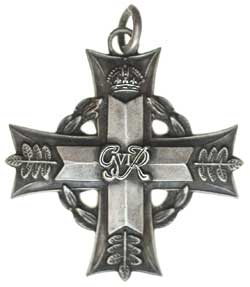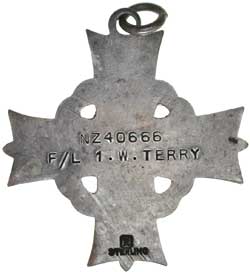Orders, Decorations & Medals - Australian Singles
Lot 3620 Session 12 (11.30am Thursday 26 March) Orders, Decorations & Medals - Australian Singles
Estimate $250
Bid at live.noble.com.au
SOLD $280
NEW ZEALAND MEMORIAL CROSS, GVIR. NZ40666 F/L I.W.Terry. Impressed. No ribbon, very fine.
Flt Lt Ian Wingate Terry, RNZAF attached 206Sqn RAF, age 25, born in Sydney, NSW, Australia, the son of John Edgar and Daisy Terry of Sydney, died 21Dec1941, France; buried Nantes (Pont-Du-Cens) Communal Cemetery, Loire-Atlantique, France.
Ian Terry attended King's School, Parramatta and then Sydney University. By 1938 he was a veterinarian surgeon with the Agriculture Dept, Hamilton, NZ. He joined RNZAF as Civil Reserve Pilot/Waikato Aero Club and gained his Pilot's wings 30Jul1940. He was commissioned 24Aug1940; Emb. for UK 14Sep1940 and attached to RAF 206 Sqn (Hudson - 32 ops) 17May1941. Note: Ian's brother, Brian Rouse Terry, went from Australia to the UK and enlisted in the RAFVR. He died on 14Aug1944 while flying with the Middle East Comm Sqn.
An account of the action in which Flt Lt Terry died. On Sunday 21st December, 1941 at 15.30, the Lockheed Hudson AM837 VX-N belonging to Squadron 206 of the RAF (Coastal Command, Group 15) left the base at Chivenor in England. The plane had four crew: Flying Officer (RAF), Rawes, Errington Douglas, Pilot, 25 yrs old Flight Lieutenant (RNZAF) Terry, Ian Wingate, Navigator, 25 yrs old Sergeant (RAF) Durrant, James William, W.Op/Air gunner, 20 yrs old.
Sergeant (RAF) Watts, Ronald Leslie, W.Op/Air Gunner, 19 yrs old They had all been on several missions but this was the first time that these four airmen flew together on a mission. Eric had flown on his first patrol for 206 Squadron on 8th October, 1941. Flight Lieutenant Terry had been with him and had been the pilot that day. The veteran was Sergeant Durrant and the latest arrival was Sergeant Watts. They were accompanied by five other Lockheed Hudsons for this mission. In 1941 the Lockheed Hudson was a plane used for aerial reconnaissance, to escort convoys of boats and to search for submarines. However, the Coastal Command had decided to use them for a raid and the target was the oil refinery at Donges, very close to the submarine base at Saint Nazaire.
The formation headed towards the target. As the objective was the oil refinery at Donges, the crew needed to face up to the terrible anti-air defence of the German submarine base which was close by. One plane returned to England with technical problems but the other five arrived near the target. Suddenly scores of searchlights illuminated the sky, followed five minutes later by a deluge of shells from the guns of 22 Marine-flak-Regiment of Saint Nazaire. The firing rate of these large calibre guns was 10 to 15 hits a minute. The searchlights looked for their prey in the sky. Suddenly, a searchlight (809 Marine Flak, 7th Company) the one from the La Moinerie farm where 10 to 12 German soldiers were staying, caught Hudson AM837 VX-N in its sights. A second searchlight followed by a third and then many more trained their beams on the plane. The guns of the 22 Marine-Flak-Regiment continued to fire without respite at this unfortunate plane.
Once AM837 VX-N was hit it quickly lost altitude. The inhabitants of the Breteche's farm, families Dousset, Soreau and Jean Durand who were there, watched helplessly as the plane which was on fire passed above them and crashed making a terrifying noise. The impact on the ground in a field known as 'le pre de ronces' was so violent that due to the speed of the plane it crossed over a little road and finally came to rest in a field called 'La Coulee'. The other planes in the mission arrived back in England at about 22.30. One can therefore estimate the time of the crash between 18.00 and 19.00.
Straightaway, as was often the case, the French, who knew the roads and the countryside so well, arrived before the German soldiers. Even though it was forbidden and very dangerous to do this, Rogatienne Ginaud, who was 25 and lived at the Moinerie farm, ran to the crash site to try and help the victims but was only able to confirm that they were dead. The German soldiers nearest to the crash who were posted in the Moulin de Saint Viaud (near the town hall) arrived soon after. The bodies were picked up and taken to Nantes that evening or the Monday morning. They were buried in the cemetery at Nantes on Christmas Eve, 24th December, 1941, without being identified.
Estimate / sale price does not include buyer's premium (currently 22% including GST) which is added to hammer price. All bids are executed on the understanding that the Terms & Conditions of sale have been read and accepted. For information on grading and estimates please refer to the Buying at Auction advice.
Quick find
View a lot by number and sale.
Adjacent lots
Lot 3618
MEMORIAL PLAQUE WWI, named to Andrew McDowell. Sometime cleaned, otherwise very fine.
Estimate $300
Lot 3619
MEMORIAL PLAQUE WWI, named to Arthur Henry Sparks. Some verdigris spotting, otherwise extremely fine.
Estimate $200
Lot 3620 This lot
NEW ZEALAND MEMORIAL CROSS, GVIR. NZ40666 F/L I.W.Terry. Impressed. No ribbon, very fine.
Estimate $250
Lot 3621
EFFICIENCY MEDAL, (GVR) with Australia suspender. Unnamed (not erased). Extremely fine.
Estimate $100
Lot 3622
COLONIAL AUXILIARY FORCES LONG SERVICE MEDAL, (QVR). G. Fullerton Late No 60, Sgt Corps of ...
Estimate $400

